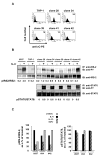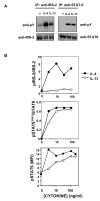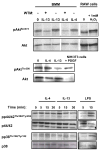Type I IL-4Rs selectively activate IRS-2 to induce target gene expression in macrophages
- PMID: 19109239
- PMCID: PMC2739727
- DOI: 10.1126/scisignal.1164795
Type I IL-4Rs selectively activate IRS-2 to induce target gene expression in macrophages
Abstract
Although interleukin-4 (IL-4) and IL-13 participate in allergic inflammation and share a receptor subunit (IL-4Ralpha), they have different functions. We compared cells expressing type I and II IL-4Rs with cells expressing only type II receptors for their responsiveness to these cytokines. IL-4 induced highly efficient, gammaC-dependent tyrosine phosphorylation of insulin receptor substrate 2 (IRS-2), whereas IL-13 was less effective, even when phosphorylation of signal transducer and activator of transcription 6 (STAT6) was maximal. Only type I receptor, gammaC-dependent signaling induced efficient association of IRS-2 with the p85 subunit of phosphoinositide 3-kinase or the adaptor protein growth factor receptor-bound protein 2. In addition, IL-4 signaling through type I IL-4Rs induced more robust expression of a subset of genes associated with alternatively activated macrophages than did IL-13. Thus, IL-4 activates signaling pathways through type I IL-4Rs qualitatively differently from IL-13, which cooperate to induce optimal gene expression.
Figures









Similar articles
-
The extracellular and transmembrane domains of the γC and interleukin (IL)-13 receptor α1 chains, not their cytoplasmic domains, dictate the nature of signaling responses to IL-4 and IL-13.J Biol Chem. 2012 Sep 14;287(38):31948-61. doi: 10.1074/jbc.M112.348896. Epub 2012 Jul 24. J Biol Chem. 2012. PMID: 22829596 Free PMC article.
-
The TORC1-activated Proteins, p70S6K and GRB10, Regulate IL-4 Signaling and M2 Macrophage Polarization by Modulating Phosphorylation of Insulin Receptor Substrate-2.J Biol Chem. 2016 Nov 25;291(48):24922-24930. doi: 10.1074/jbc.M116.756791. Epub 2016 Oct 14. J Biol Chem. 2016. PMID: 27742835 Free PMC article.
-
Interleukin-13 signal transduction in lymphohemopoietic cells. Similarities and differences in signal transduction with interleukin-4 and insulin.J Biol Chem. 1995 May 19;270(20):12286-96. doi: 10.1074/jbc.270.20.12286. J Biol Chem. 1995. PMID: 7744881
-
IL-4/IL-13 signaling beyond JAK/STAT.J Allergy Clin Immunol. 2000 Jun;105(6 Pt 1):1063-70. doi: 10.1067/mai.2000.107604. J Allergy Clin Immunol. 2000. PMID: 10856136 Review.
-
Interleukin-4, interleukin-13, signal transducer and activator of transcription factor 6, and allergic asthma.Curr Mol Med. 2008 Aug;8(5):384-92. doi: 10.2174/156652408785161032. Curr Mol Med. 2008. PMID: 18691065 Free PMC article. Review.
Cited by
-
Scorpion venom and the inflammatory response.Mediators Inflamm. 2010;2010:903295. doi: 10.1155/2010/903295. Epub 2010 Mar 14. Mediators Inflamm. 2010. PMID: 20300540 Free PMC article. Review.
-
Importance of cytokines in murine allergic airway disease and human asthma.J Immunol. 2010 Feb 15;184(4):1663-74. doi: 10.4049/jimmunol.0902185. J Immunol. 2010. PMID: 20130218 Free PMC article. Review.
-
High-Resolution Mapping and Dynamics of the Transcriptome, Transcription Factors, and Transcription Co-Factor Networks in Classically and Alternatively Activated Macrophages.Front Immunol. 2018 Jan 18;9:22. doi: 10.3389/fimmu.2018.00022. eCollection 2018. Front Immunol. 2018. PMID: 29403501 Free PMC article.
-
Inflammatory cytokines mediating the effect of oral lichen planus on oral cavity cancer risk: a univariable and multivariable mendelian randomization study.BMC Oral Health. 2024 Mar 22;24(1):375. doi: 10.1186/s12903-024-04104-0. BMC Oral Health. 2024. PMID: 38519926 Free PMC article.
-
Estrogen Signaling Contributes to Sex Differences in Macrophage Polarization during Asthma.J Immunol. 2017 Sep 1;199(5):1573-1583. doi: 10.4049/jimmunol.1601975. Epub 2017 Jul 31. J Immunol. 2017. PMID: 28760880 Free PMC article.
References
-
- Boulay JL, Paul WE. The interleukin-4 family of lymphokines. Curr Opin Immunol. 1992;4:294–298. - PubMed
-
- Sprang SR, Bazan JF. Cytokine structural taxonomy and mechanisms of receptor engagement. Curr Opin Struct Biol. 1993;3:815–827.
-
- Rozwarski DA, Gronenborn AM, Clore GM, Bazan JF, Bohm A, Wlodawer A, Hatada M, Karplus PA. Structural comparisons among the short-chain helical cytokines. Structure. 1994;2:159–173. - PubMed
-
- Minty A, Chalon P, Derocq JM, Dumont X, Guillemot JC, Kaghad M, Labit C, Leplatois P, Liauzun P, Miloux B, et al. Interleukin-13 is a new human lymphokine regulating inflammatory and immune responses. Nature. 1993;362:248–250. - PubMed
-
- Chomarat P, Banchereau J. Interleukin-4 and interleukin-13: their similarities and discrepancies. Int Rev Immunol. 1998;17:1–52. - PubMed
Publication types
MeSH terms
Substances
Grants and funding
LinkOut - more resources
Full Text Sources
Other Literature Sources
Molecular Biology Databases
Research Materials
Miscellaneous

